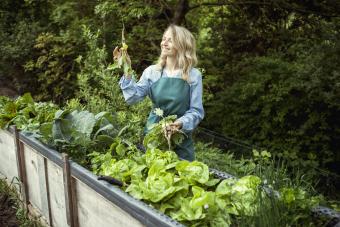
Raised beds are a great option for vegetable gardens, but for the best results, you'll want to make sure you're using the best possible soil mix. Most vegetables are heavy feeders, so to grow well and produce plenty of tasty food, they need a nutrient-rich soil. Luckily, there are several options for filling your raised bed garden with the crumbly, fertile soil your plants need.
Your Best Soil Options for a Raised Vegetable Garden
Vegetables need a few important things to thrive: nutrient-rich soil, even moisture, fertilization, and regular care and attention. But if you don't have good soil, nothing else you do will make much of a difference. That's why it's so important to fill your beds with the best soil for a raised vegetable garden. If you get this part right, everything else will go much easier.

Mix One: 50/50 Compost and Topsoil
Many people believe it's best to use local soil for raised beds. This approach takes local climate and environment into consideration for growing vegetables. Start with the easiest soil mix formula of 50% compost and 50% local topsoil.
Compost
The higher the compost quality, the more nutrients the soil has to feed plants. Most organic gardeners create their own compost. This decomposed organic matter has a recognizable texture that is dark brown and crumbly.
Of course, you can also purchase compost, either in bulk or in bags. When buying compost, it pays to do some research and shop around. Ask other gardeners what they've used and liked in their gardens.
Compost Nutrients
The best soil for growing vegetables will include plenty of compost, in large part because it's such a nutrient-rich amendment. Quality compost should contain the nutrients vegetables need for healthy growth. These include the macronutrients known as NPK: nitrogen (N), phosphorus (P) and potassium (K).
In addition to these macronutrients, compost has many beneficial micronutrients and trace minerals. Some include sulfur, manganese, iron, copper, zinc, carbon, magnesium, calcium, boron and iodine.
Topsoil
Topsoil is typically the first two to six inches of the top layer of soil. You can purchase topsoil in a loamy mixture of clay, silt and sand by the cubic yard from a landscaping supplier.

You can also buy a 40-pound bag from a local garden center. You should purchase topsoils that have been screened to reduce clumps and debris. The best bagged soil for vegetable gardens won't have debris, weed seeds or other impurities.
Poor Topsoil Solutions
Some topsoils are of very poor quality with few nutrients. This soil can provide volume to your raised bed, but will need different soils and amendments, such as compost, lime and various nutrients and trace minerals. Composted manures are quality amendments that also provide good soil texture for root growth.
Mix Two: Lasagna Gardening Soil Solution
If your budget won't allow for purchasing the soils you need to fill your raised bed, opt for the lasagna gardening method, also known as the Hugelkultur (hill mound) method. You'll start by placing twigs, leaves, and straw at the very bottom of the raised bed.
You can also use vegetable ink newspapers and various compostable foodstuffs (no meats), such as coffee grounds, egg shells, and tea leaves. These will be layered like a lasagna until you're about six to eight inches from the top of your raised bed. Don't overfill the bed.
Add Bagged Garden Soil
Next, use bagged soil to fill those last few inches. Most vegetables don't require more than 6 to 12 inches for root growth. The materials you layered beneath the bagged soil will gradually decompose and break down under the heat, water and air. The decomposing materials will slow-release nutrients. As the under layers break down and the soil compacts, you can add more layers as well as compost from your compost pile.
- Adding gardening soil to compost will build up nutrient properties.
- You should avoid using potting soil since it will drain too quickly and wash away nutrients.
Mix Three: Mel's Mix
The famous Mel's Mix, formulated by Mel Bartholomew, who popularized the Square Foot Gardening method, is the Holy Grail for most raised bed gardeners. It's mixed by volume using an easy formula consisting of:

- 1/3 coarse horticultural vermiculite
- 1/3 peat moss
- 1/3 blended compost
Climate Conditions and Plant Needs
There are instances when you may need to use a specific soil type for your gardening needs.
- Local climates can often require a different soil mix. For example, a rainy Pacific Northwest garden will need a mix that allows for good drainage, but the same soil mixture would be inappropriate for an arid desert region.
- Some plants, such as blueberries, require a more acidic soil mix for a different pH soil level.
Growing Fresh Vegetables
The key to the best soil for growing vegetables is to remember that you always want to feed the soil and not the plants. This approach ensures your soil will be rich in nutrients to support vegetable growth.







